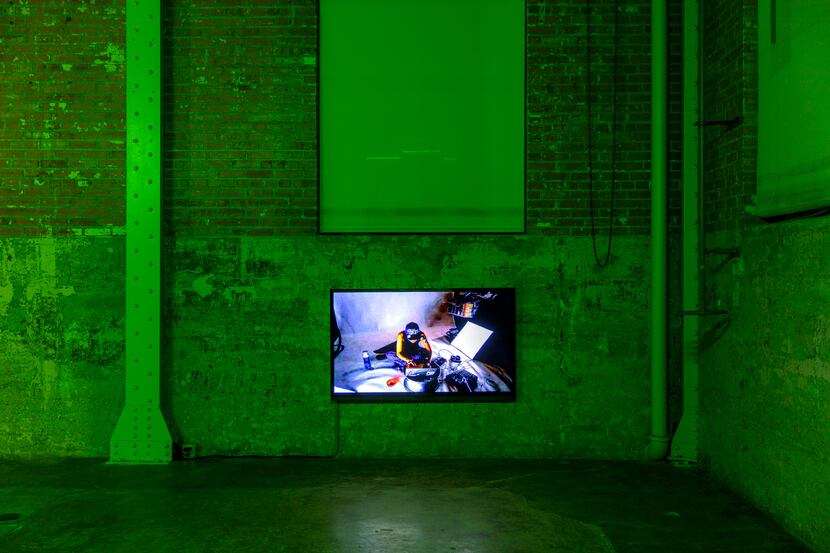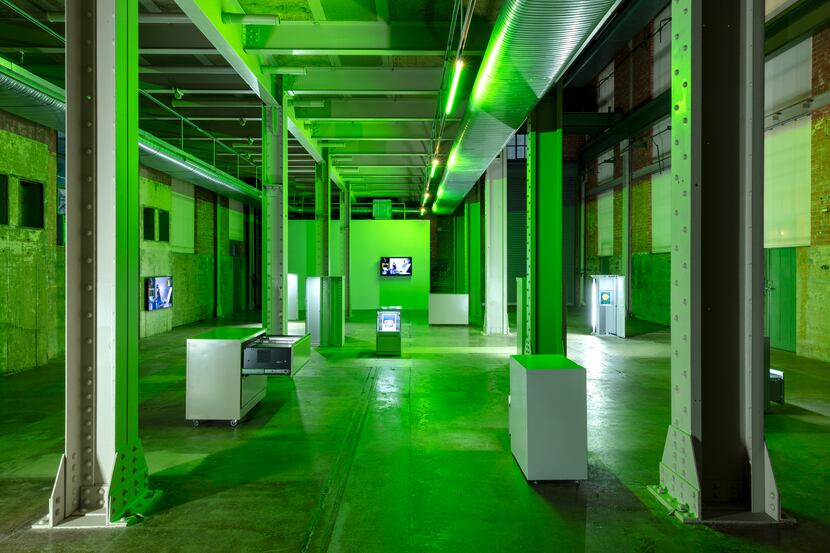Does being American make someone’s art less worthy of exploration?
That’s one of the questions being examined regarding stereotypes and the methodology of curation in an exhibition titled “Factory Settings” at the Power Station.
The show was curated by a collective that calls itself Swim Club. The duo is made up of Dallas artists SooMi Han and Gregory Ruppe.
Han is a 2020 bachelor of fine arts graduate at Southern Methodist University, where she previously curated an exhibition called “Me ²,” which reproduced internet memes in physical form using a printing process called Risograph. Ruppe is a founding member of Culture Hole, which has regularly programmed mini exhibitions at the Power Station since 2017.
“Factory Settings” features 15 Asian American artists, and the particularly American identity of the artists was important to Han.
“I really wanted to see a contemporary Asian American art exhibition,” Han says, remarking on a tendency for exhibitions to show strictly Asian artists as opposed to Asian American artists.

Ranging from a standard meme format by artist Djinn Kazama to calculatedly amorphous work, “Factory Settings” is a showcase by artists working largely online, but printed here on archival paper for posterity.
“Another thing is that specifically contemporary Asian American artists working in various alternative mediums are not often archived in institutions,” Han says. “What I’m trying to do here is bring that back into a technical archive where these communities have thrived in a digital space for so long and bring that into a physical space where the viewer is able to come in and physically scroll through all of these physical iterations of the archive.”
The artworks were submitted remotely and printed in Dallas with the Risograph process, which involves soy-based ink and rice paper. The Risograph method was developed in postwar Japan, and its organic profile and ease of use have led to something of a resurgence with artists in recent years. While a handful of the artists have roots in Dallas, Han says she has “never met a lot of them, actually.”
“It’s the most eco-friendly method of printing,” Han says. “The nature of and the purpose of Risograph is to make information very accessible, really cheap and to produce several iterations of it.”
The art in “Factory Settings” is displayed in furniture that was discarded by News Korea, a defunct newspaper near Harry Hines Boulevard. Han’s studio is located in the offices, which were abandoned during the pandemic.
The Swim Club collective will be headquartered in the studio and will be exhibiting art in the near future. The neighborhood around this section of Harry Hines holds particular significance for Han.
“I felt like it would be so special to show specifically Asian American artists, and a lot of them grew up [in the neighborhood around Harry Hines].”
The structural ghosts of the shuttered newspaper lead viewers through the Power Station to view the prints. Music from a performance by artist Cindie Xin (a.k.a. Cyn) blasts through the cavernous gallery.
“I was excited to see how people were navigating the space,” Han says. “They would come in and go through the maze with the paper and they would go out, but then they would think of an image, but they couldn’t find it so they would go back through the maze several times like: ‘Ah, this was the one I was thinking of.’ I also love that from any given point, you can’t see any more than two or three of the images.”
Han was surprised to see some familiar faces at the exhibition opening. “I think a lot of the Asian American communities were very excited to see it,” Han says. “I saw a lot of people I wasn’t expecting. You know Asian communities are very tight-knit — at least they used to be — so I would see these random people that I grew up with from years ago.”
Details
”Factory Settings” is on view by appointment through Aug. 21 at the Power Station, 3816 Commerce St., Dallas. powerstationdallas.com.

